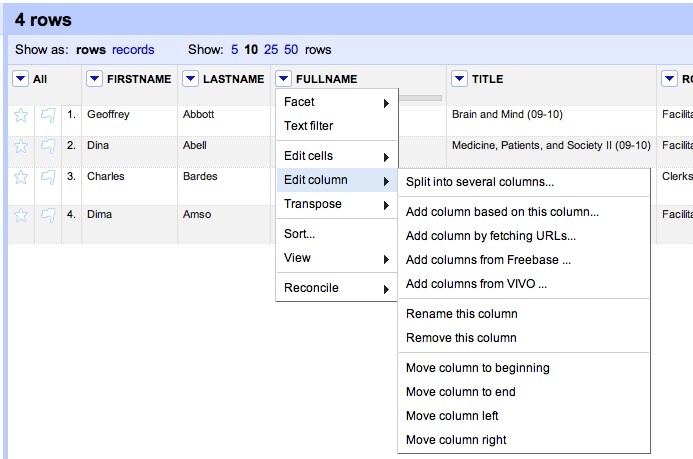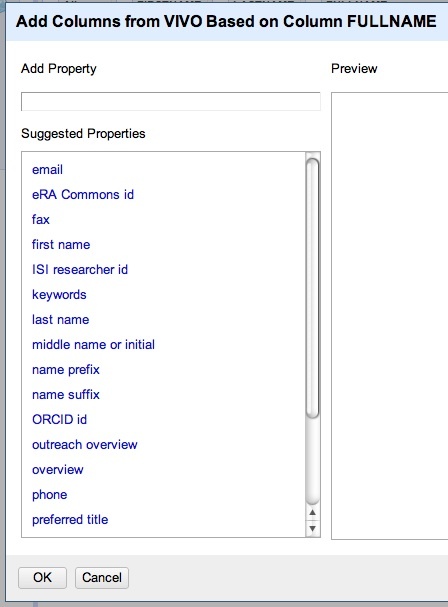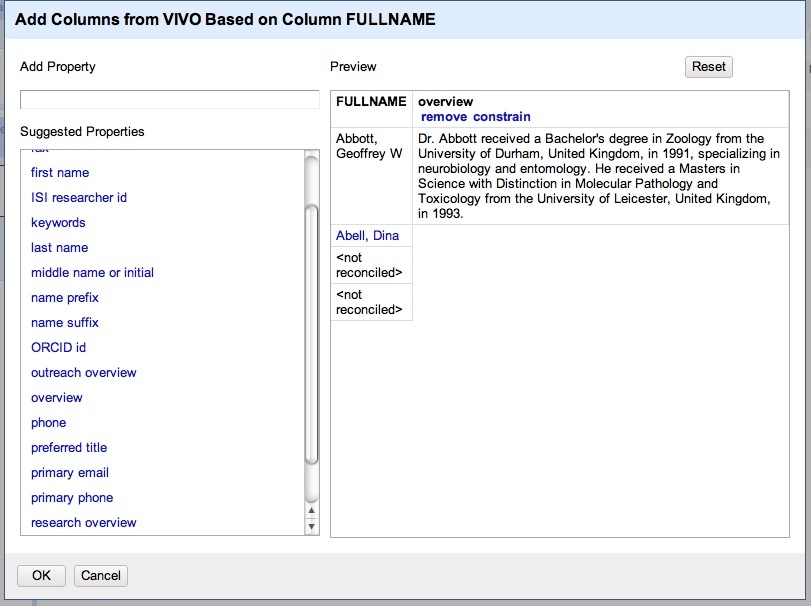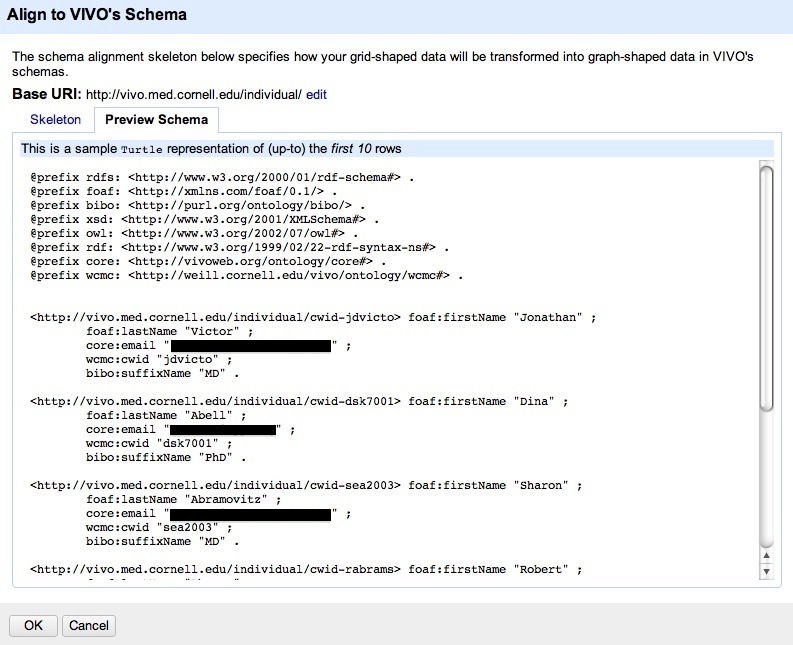Dr. Curtis L. Cole, Dan Dickinson, Kenneth Lee, Eliza Chan
Background
Google Refine (previously Freebase Gridworks) is a freely available open source software package for manipulating datasets. Google Refine strives to provide an easy-to-use toolset to assist in the extraction, review, transformation, and export of datasets. It is advertised as a "power tool for messy data".
One of Google Refine’s unique features is tight integration with the Freebase database. Freebase is a community built repository of freely available structured data. Similarly to how VIVO strives to make assertions about faculty and research at a given institution, Freebase provides a graph that connects over twelve million entities on topics ranging from political parties and diseases to amusement parks and types of tea.
Google Refine’s integration with Freebase allows users to “reconcile” data in a grid format against entities found within the Freebase graph. Users may specify an object class and additional fields to help identify a particular cell as being an entity within the Freebase graph. Google Refine communicates via an interface to Freebase to either match the cells to entities or receive a set of potential matches. Cells that are matched change to linked data, while cells with multiple potential matches can be reviewed by a user and matched by hand. After a column has been reconciled, Google Refine allows a user to add additional columns based on relationships or properties belonging to the linked entity. For example, a column of reconciled countries can have the gross domestic product or capital added easily into the same data table.
Google Refine also allows a dataset to be aligned to the Freebase schema, to convert grid data into graph data, and then export it into a triple format importable by Freebase. Because of this type integration, Google Refine is a viable, attractive tool for working with datasets that need to be converted for use within semantic web applications.
Goals
Weill Cornell Medical College proposes to enhance both Google Refine and VIVO to allow integration between the two systems, similar to the existing integration with Freebase. Specifically, we intend:
- To write an extension for Google Refine that
- will provide a series of functions to align a dataset to the VIVO core ontologies, assert relationships to help transform data from a grid to a semantic web graph, and export the data into a standardized triple format (such as N3) so that it can be easily ingested by a VIVO installation;
- will allow data to be imported into a dataset by referencing VIVO linked data, similar to the “Add columns from Freebase...” function.
- To implement the Reconciliation Service API within VIVO, providing an interface for Google Refine to reconcile data against a specified VIVO instance.
Documentation
Section I: VIVO servlet - Reconciliation service
The VIVO reconciliation service is a Java HttpServlet that parses requests from Google Refine and returns query results back to Google Refine. With each request, it also returns a callback value in order to correctly map the results to the request that it receives.
To send a request from Google Refine, click on "Reconcile -> Start reconciling" to open the reconcile dialog. Then click on the "Add Standard Service" button to add the VIVO reconciliation service. The URL to VIVO's reconciliation service should have the word "reconcile" at the end, similar to this: http://vivo.mydomain.edu/reconcile.
The VIVO reconciliation service responds to the following requests from Google Refine:
- Single query
- Typed single query
- Typed single query with properties
- Multiple queries
- No query
Reconciliation Service API Test Dashboard
The Reconciliation Service API Test Dashboard provides an insight on the backend of the reconciliation service.
In their examples, the JSON queries that appear after clicking on the query text links illustrate the kind of queries that Google Refine's reconciliation service would send to its target reconcile service. Upon receiving the queries, the reconcile service would parse the queries and send the results back to Google Refine.
Here is an example of a query being sent to VIVO from Google Refine:
{"q0":{"query":"Cathleen","type":"http://xmlns.com/foaf/0.1/Person","type_strict":"should"}}
Here is an example of the results returned from VIVO to Google Refine:
{
"q0": {
"result": [
{
"id": "http://vivo.med.cornell.edu/individual/cwid-clr9010",
"name": "Raggio, Cathleen L.",
"score": 0.15898549556732178,
"match": "false",
"type": [
{
"id": "http://xmlns.com/foaf/0.1/Agent",
"name": "Agent"
},
{
"id": "http://vivoweb.org/ontology/core#FacultyMember",
"name": "core:FacultyMember"
},
{
"id": "http://xmlns.com/foaf/0.1/Person",
"name": "Person"
}
]
},
{
"id": "http://vivo.med.cornell.edu/individual/cwid-cacres",
"name": "Acres, Cathleen",
"score": 0.15898549556732178,
"match": "false",
"type": [
{
"id": "http://xmlns.com/foaf/0.1/Agent",
"name": "Agent"
},
{
"id": "http://vivoweb.org/ontology/core#NonFacultyAcademic",
"name": "core:NonFacultyAcademic"
},
{
"id": "http://xmlns.com/foaf/0.1/Person",
"name": "Person"
}
]
},
{
"id": "http://vivo.med.cornell.edu/individual/cwid-cal9048",
"name": "London, Cathleen",
"score": 0.15898549556732178,
"match": "false",
"type": [
{
"id": "http://xmlns.com/foaf/0.1/Agent",
"name": "Agent"
},
{
"id": "http://vivoweb.org/ontology/core#FacultyMember",
"name": "core:FacultyMember"
},
{
"id": "http://xmlns.com/foaf/0.1/Person",
"name": "Person"
}
]
}
]
}
}
VIVO Reconciliation Service Work Case Scenario
1) In this example, the user wanted to find out if any of the names listed could be reconciled (or matched) with those in a VIVO instance
2) To open the reconcile dialog, select the menu item "Start reconciling ..."
3) When the reconcile dialog opens, click on the button "Add Standard Service ..." (not shown in diagram) to add the service's URL. The URL is typically http://your-vivo-site/reconcile. After adding the service, click on the service item and the types that match with the column would appear (see diagram below). In this case, the type core:NonFacultyAcademic was selected.
4) In this example, matches were found for three names, and the suggested matches were imported from the VIVO instance. To select the matched names, click on the check boxes next to the names.
Summary
The VIVO reconciliation service is a Java HttpServlet that responds to requests from Google Refine, and returns results in JSON format in accordance to Google Refine's Reconciliation Service API.
Section II: VIVO servlet - Property listings
The VIVO property listings service is a Java HttpServlet that receives requests for data properties for given classes from Google Refine and returns query results back to Google Refine.
The path to the property listings service is /get_properties_of_type, and the full path is similar to this: http://vivo.mydomain.edu/get_properties_of_type.
Two parameters are passed to the servlet, type and callback. For instance, to request for data properties associated with the class foaf:Person, the query string would be similar to the following:
See below an example of the response in json format:
jsonp1313077460641 (
{
"properties":
[
{
"id":"http://vivoweb.org/ontology/core#faxNumber",
"schema":{"id":"http://xmlns.com/foaf/0.1/Agent","alias":[],"name":"Agent"},
"alias":[],"name":"fax",
"expects":{"id":"http://vivoweb.org/ontology/core#faxNumber","alias":[],"name":"fax"}
},
{
"id":"http://vivoweb.org/ontology/core#overview",
"schema":{"id":"http://xmlns.com/foaf/0.1/Agent","alias":[],"name":"Agent"},
"alias":[],"name":"overview",
"expects":{"id":"http://vivoweb.org/ontology/core#overview","alias":[],"name":"overview"}
}
]
}
)
VIVO Property Listings Work Case Scenario
1) In this example, names have been reconciled with a VIVO instance.
2) Click on the menu item "Add columns from VIVO" to search the VIVO instance for data properties that are associated with the reconciled names.
3) In this case, the class foaf:Person was used for the reconciliation, and its associated data properties are listed in the Suggested Properties box.
Section III: VIVO servlet - MQL read
The VIVO MQL read service is a Java HttpServlet that receives requests for values of data properties from Google Refine and returns query results back to Google Refine.
The path to the MQL read service is /grefineMqlread, and the full path is similar to this: http://vivo.mydomain.edu/grefineMqlread.
The requests and response are in json format that comply with the mqlread API.
See below an example of a query and a response:
{"query":
[
{
"id":null,
"id|=":["http://vivo.med.cornell.edu/individual/n3704","http://vivo.med.cornell.edu/individual/n3526"],
"http://xmlns.com/foaf/0.1/firstName": [{"optional":true,"limit":10,"name":null,"id":null,"type":[]}]
}
]
}
{"result":
[
{"id":"http://vivo.med.cornell.edu/individual/n3704","http://xmlns.com/foaf/0.1/firstName":["Geoffrey"]},
{"id":"http://vivo.med.cornell.edu/individual/n3526","http://xmlns.com/foaf/0.1/firstName":["Dina"]}
]
}
VIVO MQL Read Service Work Case Scenario
1) In this example, the overview value associated with the person was displayed in the Preview panel
2) An overview column was added to Google Refine
Section IV: Google Refine VIVO extension - Align to VIVO's schema
Google Refine has a documentation page about writing an extension. In addition, the "RDF Extension" project provides an excellent demonstration of a functional Google Refine extension.
The following work case scenario demonstrates how grid-shaped data can be aligned to VIVO's schema and transformed into RDF.
1) In this example, the VIVO instance was missing the email and suffix for the people listed. The goal was to align the missing data to the VIVO schema so that it could be imported to a VIVO instance. To open the alignment dialog, click on the menu item “Align to VIVO’s schema…”.
2) Align the properties to the VIVO schema
The initial dialog shows a “skeleton” that the user would need to specify which columns were to be aligned with which VIVO properties.
The following dialog shows the columns that had been aligned to the VIVO properties.
3) After completion of the alignment, the Preview Schema tab showed the first 10 rows of the resulting RDF data.
Installation
Prerequisites
- Make sure the following are installed on the desired machine:
- :Java (SE) 1.6 or higher, http://java.sun.com
- :Apache Ant 1.7 or higher, http://ant.apache.org
- Download Google Refine version 2.5 from http://code.google.com/p/google-refine/. If you have Subversion installed and access to a command line, you can use the following command to checkout the 2.5 release:
- :svn checkout http://google-refine.googlecode.com/svn/tags/2.5 grefine-googlecode-2.5
- Download the VIVO plugin and Google Refine extension from http://sourceforge.net/projects/vivo/files/Utilities, or click on one of the following links:
- :grefine-vivo-1.5.tar.gz or grefine-vivo-1.5.zip
- :Unpack and you will find the following files and folder: i) grefine-vivo-extension; ii) README
- Download and install VIVO release version 1.5 from http://sourceforge.net/projects/vivo/files/, if you have not already done so.
Google Refine+VIVO Extension Installation
- Copy
grefine-vivo-extensionto Google Refine's extension folder so that it becomes/extension/grefine-vivo-extension - Rename from
/extension/grefine-vivo-extensionto/extension/vivo(required) - Modify
/extensions/build.xmlto add vivo to build and clean:<target name="build">
<echo message="Building extensions" />
<ant dir="sample/" target="build" />
<ant dir="jython/" target="build" />
<ant dir="freebase/" target="build" />
<ant dir="gdata/" target="build" />
<ant dir="vivo/" target="build" />
</target>
<target name="clean">
<echo message="cleaning extensions" />
<ant dir="sample/" target="clean" />
<ant dir="jython/" target="clean" />
<ant dir="freebase/" target="clean" />
<ant dir="gdata/" target="clean" />
<ant dir="vivo/" target="clean" />
</target> - Run
./refine clean - Run
./refine build - To start Google Refine, run
./refine
Contributing to the project
We welcome anyone with a deep interest in Google Refine and/or VIVO to get involved.
The following mailing lists are highly recommended for support and discussions:
- google-refine@googlegroups.com
- vivo-dev-all@lists.sourceforge.net
References
1. The Google Refine VIVO extension was adapted and modified from the RDF extension project (http://lab.linkeddata.deri.ie/2010/grefine-rdf-extension/).
Useful tips
1. Google Refine expression to get the resource URI from reconciled cells
e.g. cells.fullname.recon.best.id











